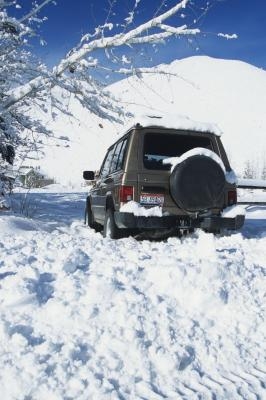
The rear axle transfers turning power from the transmission to the rear wheels to move your vehicle. Over time, wear or damage to internal components will cause the rear axle to leak, become noisy or fail to operate properly. Check for common trouble spots on your rear axle before beginning to disassemble components for a replacement job. Taking the time to diagnose a rear axle problem might end up saving you time and money.
Tighten the rear-wheel lug nuts using a lug wrench, then tighten the wheel hub-retaining nut using a spindle nut socket. This is especially important if you hear a clunking sound when you engage the clutch, accelerate or decelerate. Ignoring this clunking noise might also lead to worn differential bearings, axle side gears, pinions, and a loose or broken universal joint.
Inspect the rear wheel bearings for wear, which might cause the wheels to produce a noise when moving forward.
Tighten the bearing cap-to-axle housing bolts using a ratchet and socket. These caps hold the shafts in place that extend from the center of the rear axle to the rear wheels. Check the service manual for your particular model for the correct torque on these bolts.
Check for loose fasteners or damage to the universal joint. Tighten the bolts with a ratchet and socket or replace them if necessary.
Check the fluid level inside the axle housing by removing the filler plug with a wrench. Low fluid level will cause a noise in the axle when you are driving straight ahead. Add the correct gear oil for your vehicle model, if necessary.
Inspect for damage to seals, gaskets, fill plug threads and the rear axle housing, if you find that the rear axle is leaking.
Remove the rear axle housing cover using the ratchet and socket. Check for loose ring gear fasteners. The service manual for your vehicle will have the torque and procedure to tighten these bolts in your rear axle.
Inspect for a dry pinion shaft seal inside the rear axle housing. The pinion is the cone-shaped component with the end gear that engages the ring gear inside the rear axle.
Inspect the condition of the pinion gears inside the rear axle housing. Worn or broken teeth on the pinion will cause noise when the vehicle turns right or left.
Check for worn case bearings, worn drive pinion shaft bearings, or ring and pinion wear.